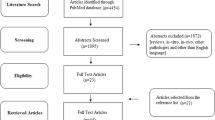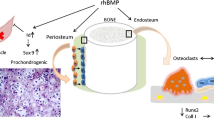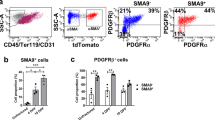Abstract
Promotion of rhBMP2 and rhBMP7 for the routine use to support fracture healing has been hampered by high costs, safety concerns and reasonable failure rates, imposing restrictions in its clinical use. Since there is little debate regarding its treatment potential, there is rising need for a better understanding of the mode of action of these BMPs to overcome its drawbacks and promote more efficacious treatment strategies for bone regeneration. Recently, BMP9, owing to its improved osteogenic potential, is gaining attention as a promising therapeutic alternative. Our study aimed at identifying specific gene expression patterns which may predict and explain individual responses to rhBMP7 and rhBMP9 treatments. Therefore, we investigated the effect of rhBMP7 and rhBMP9 on primary human osteoblasts from 110 donors and corresponding THP-1-derived osteoclasts. This was further compared with each other and our reported data on rhBMP2 response. Based on the individual donor response, we found three donor groups profiting from rhBMP treatment either directly via stimulation of osteoblast function or viability and/or indirectly via inhibition of osteoclasts. The response on rhBMP7 treatment correlated with expression levels of the genes BAMBI, SOST, Noggin, Smad4 and RANKL, while the response of rhBMP9 correlated to the expression levels of Alk6, Endoglin, Smurf1, Smurf2, SOST and RANKL in these donors. Noteworthy, rhBMP9 treatment showed significantly increased osteogenic activity (AP activity and Smad nuclear translocation) when compared to the two clinically used rhBMPs. Based on patient’s respective expression profiles, clinical application of rhBMP9 either solely or in combination with rhBMP2 and/or rhBMP7 can become a promising new approach to fit the patient’s needs to promote fracture healing.





Similar content being viewed by others
References
Alt V, Heissel A (2006) Economic considerations for the use of recombinant human bone morphogenetic protein-2 in open tibial fractures in Europe: the German model. Curr Med Res Opin 22(Suppl 1):S19–S22. doi:10.1185/030079906X80602
Ann EJ, Kim HY, Choi YH et al (2011) Inhibition of Notch1 signaling by Runx2 during osteoblast differentiation. J Bone Miner Res 26(2):317–330. doi:10.1002/jbmr.227
Barbara NP, Wrana JL, Letarte M (1999) Endoglin is an accessory protein that interacts with the signaling receptor complex of multiple members of the transforming growth factor-beta superfamily. J Biol Chem 274(2):584–594. doi:10.1074/jbc.274.2.584
Baron R, Kneissel M (2013) WNT signaling in bone homeostasis and disease: from human mutations to treatments. Nat Med 19(2):179–192. doi:10.1038/nm.3074
Beederman M, Lamplot JD, Nan G et al (2013) BMP signaling in mesenchymal stem cell differentiation and bone formation. J Biomed Sci Eng 6(8A):32–52. doi:10.4236/jbise.2013.68A1004
Boerckel JD, Kolambkar YM, Dupont KM et al (2011) Effects of protein dose and delivery system on BMP-mediated bone regeneration. Biomaterials 32(22):5241–5251. doi:10.1016/j.biomaterials.2011.03.063
Chen G, Deng C, Li YP (2012) TGF-beta and BMP signaling in osteoblast differentiation and bone formation. Int J Biol Sci 8(2):272–288. doi:10.7150/ijbs.2929
Cheng HW, Jiang W, Phillips FM et al (2003) Osteogenic activity of the fourteen types of human bone morphogenetic proteins (BMPs). J Bone Joint Surg Am 85A(8):1544–1552
David L, Mallet C, Mazerbourg S, Feige JJ, Bailly S (2007) Identification of BMP9 and BMP10 as functional activators of the orphan activin receptor-like kinase 1 (ALK1) in endothelial cells. Blood 109(5):1953–1961. doi:10.1182/blood-2006-07-034124
Dean DB, Watson JT, Jin W et al (2010) Distinct functionalities of bone morphogenetic protein antagonists during fracture healing in mice. J Anat 216(5):625–630. doi:10.1111/j.1469-7580.2010.01214.x
Dumont RJ, Dayoub H, Li JZ et al (2002) Ex vivo bone morphogenetic protein-9 gene therapy using human mesenchymal stem cells induces spinal fusion in rodents. Neurosurgery 51(5):1239–1244
Ehnert S, Baur J, Schmitt A et al (2010) TGF-beta1 as possible link between loss of bone mineral density and chronic inflammation. PLoS One 5(11):e14073. doi:10.1371/journal.pone.0014073
Ehnert S, Aspera-Werz RH, Freude T et al (2016) Distinct gene expression pattern define human osteoblasts’ response towards BMP2-treatment—Is the therapeutic success all a matter of timing? Eur Surg Res (in press)
Garrison KR, Donell S, Ryder J et al (2007) Clinical effectiveness and cost-effectiveness of bone morphogenetic proteins in the non-healing of fractures and spinal fusion: a systematic review. Health Technol Assess 30:1–150
Garrison KR, Shemilt I, Donell S et al (2010) Bone morphogenetic protein (BMP) for fracture healing in adults. Cochrane Database Syst Rev (6):CD006950
Govender S, Csimma C, Genant HK et al (2002a) Recombinant human bone morphogenetic protein-2 for treatment of open tibial fractures: a prospective, controlled, randomized study of four hundred and fifty patients. J Bone Joint Surg Am 84-A(12):2123–2134
Govender S, Csimma C, Genant HK, Valentin-Opran A, Grp BS (2002b) Recombinant human bone morphogenetic protein-2 for treatment of open tibial fractures: a prospective, controlled, randomized study of four hundred and fifty patients. J Bone Joint Surg Am 84A(12):2123–2134
Hatsell SJ, Idone V, Wolken DM et al (2015) ACVR1R206H receptor mutation causes fibrodysplasia ossificans progressiva by imparting responsiveness to activin A. Sci Transl Med 7(303):303ra137. doi:10.1126/scitranslmed.aac4358
Israel DI, Nove J, Kerns KM et al (1996) Heterodimeric bone morphogenetic proteins show enhanced activity in vitro and in vivo. Growth Factors 13(3–4):291–300
Kamiya N, Ye L, Kobayashi T et al (2008) BMP signaling negatively regulates bone mass through sclerostin by inhibiting the canonical Wnt pathway. Development 135(22):3801–3811. doi:10.1242/dev.025825
Kamiya N, Kobayashi T, Mochida Y et al (2010) Wnt inhibitors Dkk1 and sost are downstream targets of BMP signaling through the type IA receptor (BMPRIA) in osteoblasts. J Bone Miner Res 25(2):200–210. doi:10.1359/jbmr.090806
Kang Q, Sun MH, Cheng H et al (2004) Characterization of the distinct orthotopic bone-forming activity of 14 BMPs using recombinant adenovirus-mediated gene delivery. Gene Ther 11(17):1312–1320. doi:10.1038/sj.gt.3302298
Kloen P, Lauzier D, Hamdy RC (2012) Co-expression of BMPs and BMP-inhibitors in human fractures and non-unions. Bone 51(1):59–68. doi:10.1016/j.bone.2012.03.032
Lamplot JD, Qin J, Nan G et al (2013) BMP9 signaling in stem cell differentiation and osteogenesis. Am J Stem Cells 2(1):1–21
Li JZ, Hankins GR, Kao CH, Li HW, Kammauff J, Helm GA (2003a) Osteogenesis in rats induced by a novel recombinant helper-dependent bone morphogenetic protein-9 (BMP-9) adenovirus. J Gene Med 5(9):748–756. doi:10.1002/jgm.412
Li JZ, Li H, Sasaki T et al (2003b) Osteogenic potential of five different recombinant human bone morphogenetic protein adenoviral vectors in the rat. Gene Ther 10(20):1735–1743. doi:10.1038/sj.gt.3302075
Lissenberg-Thunnissen SN, de Gorter DJ, Sier CF, Schipper IB (2011) Use and efficacy of bone morphogenetic proteins in fracture healing. Int Orthop 35(9):1271–1280. doi:10.1007/s00264-011-1301-z
Luther G, Wagner ER, Zhu GH et al (2011) BMP-9 induced osteogenic differentiation of mesenchymal stem cells: molecular mechanism and therapeutic potential. Curr Gene Ther 11(3):229–240
Miyazono K, Kamiya Y, Morikawa M (2010) Bone morphogenetic protein receptors and signal transduction. J Biochem 147(1):35–51. doi:10.1093/jb/mvp148
Olsen OE, Wader KF, Misund K et al (2014) Bone morphogenetic protein-9 suppresses growth of myeloma cells by signaling through ALK2 but is inhibited by endoglin. Blood Cancer J. doi:10.1038/bcj.2014.16
Onichtchouk D, Chen YG, Dosch R et al (1999) Silencing of TGF-beta signalling by the pseudoreceptor BAMBI. Nature 401(6752):480–485. doi:10.1038/46794
Scherner O, Meurer SK, Tihaa L, Gressner AM, Weiskirchen R (2007) Endoglin differentially modulates antagonistic transforming growth factor-beta1 and BMP-7 signaling. J Biol Chem 282(19):13934–13943. doi:10.1074/jbc.M611062200
Shen BJ, Bhargav D, Wei AQ et al (2009) BMP-13 emerges as a potential inhibitor of bone formation. Int J Biol Sci 5(2):192–200
Shi Y, Massague J (2003) Mechanisms of TGF-beta signaling from cell membrane to the nucleus. Cell 113(6):685–700
Shimer AL, Oner FC, Vaccaro AR (2009a) Spinal reconstruction and bone morphogenetic proteins: open questions. Injury 40(Suppl 3):S32–S38. doi:10.1016/S0020-1383(09)70009-9
Shimer AL, Oner FC, Vaccaro AR (2009b) Spinal reconstruction and bone morphogenetic proteins: open questions. Injury 40:32–38. doi:10.1016/S0020-1383(09)70009-9
Soares-Schanoski A, Gomez-Pina V, del Fresno C et al (2007) 6-Methylprednisolone down-regulates IRAK-M in human and murine osteoclasts and boosts bone-resorbing activity: a putative mechanism for corticoid-induced osteoporosis. J Leukoc Biol 82(3):700–709. doi:10.1189/jlb.1106673
Tan X, Weng T, Zhang J et al (2007) Smad4 is required for maintaining normal murine postnatal bone homeostasis. J Cell Sci 120(Pt 13):2162–2170. doi:10.1242/jcs.03466
van Baardewijk LJ, van der Ende J, Lissenberg-Thunnissen S et al (2013) Circulating bone morphogenetic protein levels and delayed fracture healing. Int Orthop 37(3):523–527. doi:10.1007/s00264-012-1750-z
Wang Y, Hong SQ, Li M et al (2013) Noggin resistance contributes to the potent osteogenic capability of BMP9 in mesenchymal stem cells. J Orthop Res 31(11):1796–1803. doi:10.1002/jor.22427
Weiskirchen R, Meurer SK, Gressner OA, Herrmann J, Borkham-Kamphorst E, Gressner AM (2009) BMP-7 as antagonist of organ fibrosis. Front Biosci (Landmark Ed) 14:4992–5012
Wu NN, Zhao YZ, Yin YB, Zhang Y, Luo JY (2010) Identification and analysis of type II TGF-beta receptors in BMP-9-induced osteogenic differentiation of C3H10T1/2 mesenchymal stem cells. Acta Bioch Bioph Sin 42(10):699–708. doi:10.1093/abbs/gmq075
Zhang JF, Fu WM, He ML et al (2011) MiRNA-20a promotes osteogenic differentiation of human mesenchymal stem cells by co-regulating BMP signaling. RNA Biol 8(5):829–838. doi:10.4161/rna.8.5.16043
Acknowledgments
We’d like to thank Hanna Scheffler and Rebecca Haupt for their excellent technical assistance. This work was partially supported by the intramural funding of the Eberhard Karls Universität Tübingen (fortüne Junior 2174-0-0) and the BBraun Foundation.
Author information
Authors and Affiliations
Corresponding author
Electronic supplementary material
Below is the link to the electronic supplementary material.
Supplementary Figure 1
BMP and Wnt signaling cascades during osteoblastogenesis and osteoclastogenesis. (A) Classically, BMP dimers bind to a receptor complex consisting of a type 1 and type 2 receptor to initiate intracellular signaling. In the presence of a co-receptor some BMPs might also initiate the intracellular signaling via an alternative receptor complex. The receptor complex is specific for the different BMPs. Upon receptor binding the transcription factors Smad1, -5 and -8 get activated (phosphorylated) and can translocate into the nucleus upon binding to Smad4 in order to initiate target gene expression. Wnt initiates its signaling via the receptors Frizzled and LRP5/6. Activation of this receptor complex inhibits the glycogen synthase kinase-3β (GSK-3β), which then can no longer favor degradation of β-catenin. β-catenin in turn can support nuclear translocation of the Smad1, -5 and -8 complex. BMP7 inhibitors include the extracellular Noggin, the membrane bound BAMBI and the intracellular Smad6 and -7, as well as Smurf1 and -2. Wnt inhibitors include Sclerostin (SOST), Dickkopf 1 and 2 (DKK1 and DKK2). Functional BMP7 and Wnt signaling regulates the expression of receptor activator of NF-kB ligand (RANKL) and its antagonist osteoprotegerin (OPG) which regulate osteoclastogenesis. (B) Overview on the composition of classical (solid line) and alternative (dotted line) receptor complex for BMP2, -7 and -9 (TIFF 9520 kb)
Rights and permissions
About this article
Cite this article
Sreekumar, V., Aspera-Werz, R.H., Tendulkar, G. et al. BMP9 a possible alternative drug for the recently withdrawn BMP7? New perspectives for (re-)implementation by personalized medicine. Arch Toxicol 91, 1353–1366 (2017). https://doi.org/10.1007/s00204-016-1796-6
Received:
Accepted:
Published:
Issue Date:
DOI: https://doi.org/10.1007/s00204-016-1796-6




